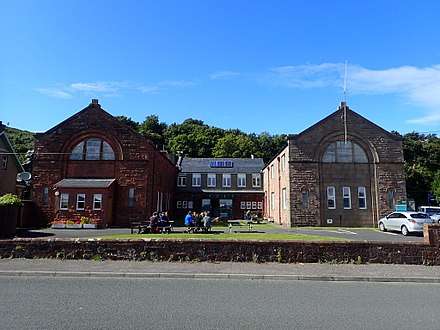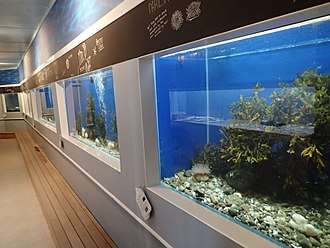FSC Millport
FSC Millport, run by the Field Studies Council, is located on the island of Great Cumbrae in the Firth of Clyde, Scotland. It reopened as a field centre in 2013 after closing in 2014 after Higher Education funding was withdrawn: it was formerly known as the University Marine Biological Station Millport (UMBSM), a higher education institute run by the University of London in partnership with Glasgow University. It continues to host and teach university, school, and college groups, as well as providing a range of courses in natural history, and over the summer offers a range of nature-based activities for families to enjoy. The Robertson Museum and Aquarium (named after the founder of the original Marine Station, David Robertson) is open to visitors all year round.[1] The station also functions as a Meteorological Office Weather Station and Admiralty Tide Monitor.

History
The Ark, an 84 ft lighter moored in the flooded Granton quarry, was fitted out as a floating laboratory by the father of modern oceanography, Sir John Murray. This boat formed the Scottish Marine Station for 12 years from 1884. In 1885 she was moved from Granton and drawn up on the shore at Port Loy, Cumbrae, where she continued to be used as a floating laboratory.[2] She attracted a stream of distinguished scientists, drawn by the richness of the fauna and flora of the Firth of Clyde, but gradually fell into disuse after the opening of the Millport Marine Station, and on the night of 20 January 1900 was completely destroyed by a great storm.[3]
In 1894 a committee headed by amateur naturalist David Robertson began to build a marine station on the Isle of Cumbrae and took over the Ark. Sadly David Robertson died the same year, but in 1897 Millport Marine Biological Station (MMBS) was opened by Sir John Murray.[3] Despite many struggles during its first few decades, in which sufficient funding was difficult to attain and there was much conflict between research priorities and the needs of education, the station persisted.
On 21 July 1904 Scotia, the ship of Dr William Speirs Bruce's Scottish National Antarctic Expedition, returned to her first Scottish landing site on the Isle of Cumbrae.
From this beginning, the station was gradually built up to its present size. The original building proved too small for the purpose and an architectural copy was built alongside. In 1914 the Scottish Marine Biological Association was established at MMBS. In 1922 Sheina Marshall joined the Scottish Marine Laboratory, beginning a scientific career dedicated to the study of plant and animal plankton. She went on to become one of the first women to be elected a Fellow of the Royal Society of Edinburgh, and later became a Fellow of the Royal Society, as well as being awarded the Order of the British Empire in 1966. From 1966 to 1987 the station ran under the Directorship of Ronald Ian Currie FRSE who was responsible for the creation of RV Challenger and RV Calanus.[4]
In 1970 the Scottish Marine Biological Station moved to Dunstaffnage Bay (Oban), and MMBS was taken over by the University of London in partnership with Glasgow University, becoming the University Marine Biological Station Millport (UMBSM).[2] It continued to expand, with a hostel accommodation block opening in 1975.
In December 2012 it was announced that the University Marine Biological Station Millport would be forced to close after the Higher Education Funding Council for England withdrew the grant of 400,000 pounds that it gave to the University of London to run the station.[5] UMBSM closed on 31 October 2013.[2]

Ownership of MMBS was transferred to the Field Studies Council on 1 January 2014.[2] In May 2014 a four-million-pound package of funding was announced that is intended to allow a comprehensive programme of development and refurbishment to be completed over five years.[6] MMBS is now known as FSC Millport and continues to deliver education alongside important research.
See also
References
- ↑ "Robertson Museum and Aquarium - FSC Millport". www.field-studies-council.org. Retrieved 2017-08-07.
- 1 2 3 4 "History - FSC Millport". www.field-studies-council.org. Retrieved 2017-08-07.
- 1 2 Marshall, Sheina M. (1987). "An Account of the Marine Station at Millport". Occasional Publication No. 4.
- ↑ "Ronal Currie Obituary" (PDF).
- ↑ "University Marine Biological Station Millport may close". BBC News. 2012-12-20. Retrieved 2017-08-07.
- ↑ "Millport Marine Research Stations Reopens". www.buildscotland.co.uk. Retrieved 2017-08-07.